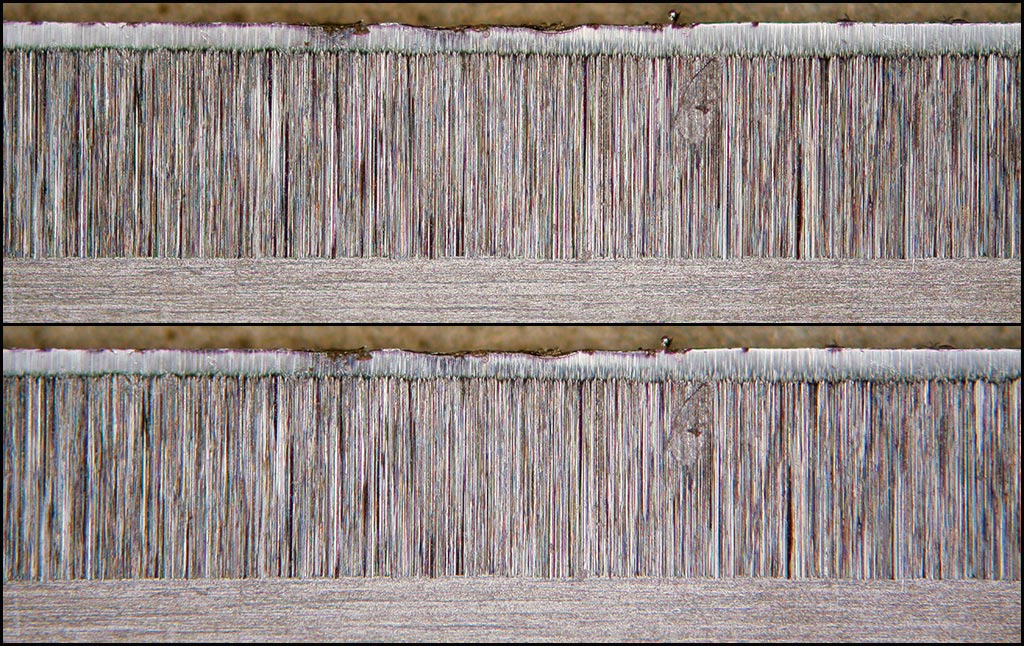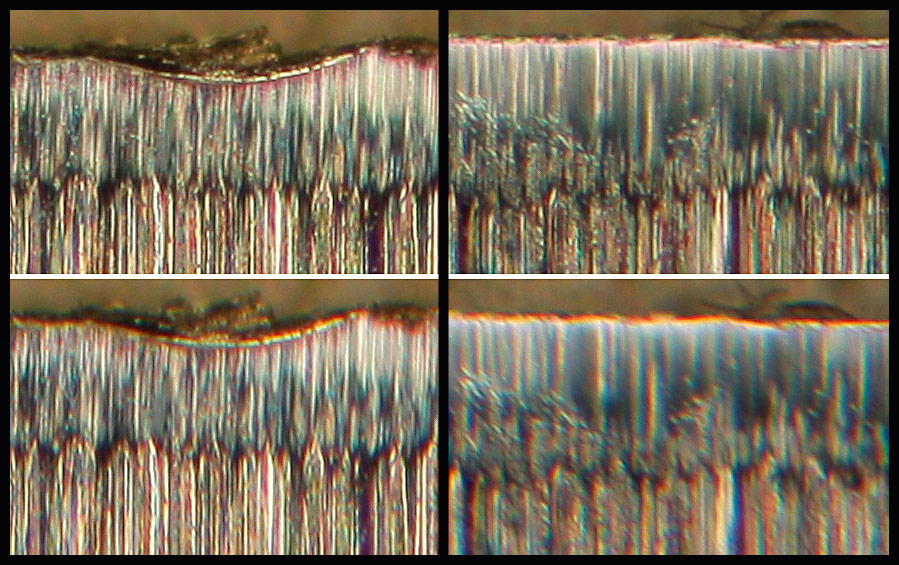The Olympus NFK 1.67X projection photo-
I wondered if elevating a NFK 2.5X in the trinocular tube above it’s normal location could provide comparable results (magnification and quality) to the NFK 1.67X. You can still find a NFK 2.5X for a fairly reasonable price. If you elevate an eyepiece in the trinocular tube it will project a smaller image into the camera (the camera needs to be mounted lower as well in order to keep it parfocal with the viewing eyepieces). But could a NFK 2.5X be made to provide this lower magnification without causing optical problems?
I photographed the edge of a well used stainless steel razor blade (placed on top of a coin). First I used the NFK 1.67X. Then I photographed the same compositions using a NFK 2.5X that was slightly elevated in the trinocular tube in order to provide the same magnification as the 1.67X. Three separate images were made. I ran the edge through the top of the frame, the center, then at the very bottom.
Here are the full frames as they were photographed:

I used this subject because it has very straight lines (easy to see any distortion),
and the fine shiny surface grooves yield very bright linear highlights . It can be
nightmarish subject to photograph with “hard” light since any CA becomes extremely
apparent... but that's what I'm looking for here. (I made little effort to keep my
overall color balance consistent... so don't look at that aspect. But the files in
the magnified 4-
The first comparison (below) is made up of the lower portion of the images where the blade edge ran through the center of the image. On top is the NFK 1.67. The bottom half is the NFK 2.5 elevated in the tube, and camera lowered, to provide a similar (1.67X) magnification.

Apparent in this comparison (above) is that "elevating" the eyepiece in this manner introduced an amount of pincushion distortion.
Greater magnification is needed to check for chromatic aberration and resolution changes. Using the same images (where the edge ran through the center of the frame), I took a piece from near the center of the blade edge (near the center of the picture), and a piece from the far right side of the blade edge (at the right edge of the picture). This comparison is shown below at 100%. The top two panels are from the NFK 1.67X (center/right side of frame), the bottom two are from the "elevated" NFK 2.5X. Looking at this it's obvious the centers are nearly equal, but at the right side of the image the elevated NFK 2.5 image is deteriorating.

Finally (below) I took the images where the blade edge ran along the bottom of the frame. Again I took a small piece from near the middle of the blade edge, and a small piece from the far right side of the blade edge (which would correspond to the lower right hand corner of the frame). As before the top two panels are from the NFK 1.67X (center/right side of frame), the bottom two are from the elevated NFK 2.5X. The NFK 1.67X holds up nicely, with the corner of the frame losing a bit compared to above, but overall very good. The elevated NFK 2.5X really starts to fall apart overall, and chromatic aberrations are very apparent.

So (not really a surprise!) it seems that it is best to use these particular photo-
I can't say if these results would hold true with other eyepieces if used in a manner for which they were not designed. My inclination, based on this comparison, it to always use these eyepieces at the distance and magnifications for which they were designed.
The NFK 2.5X used with a "reduced frame" DSLR (at it’s designed 2.5X) provides a field number of about 11mm. While, when viewing through 10X eyepieces, this may be too much of a "crop" for some people, it's not hard to get used to (and some may actually prefer it).
Charles Krebs
January 2010
Can an Olympus NFK 2.5X be used effectively at a lower magnification?
It’s often desirable to have a projection magnification less than 2.5X when using DSLRs with an “APS” sized
sensor, but appropriate corrective photo-